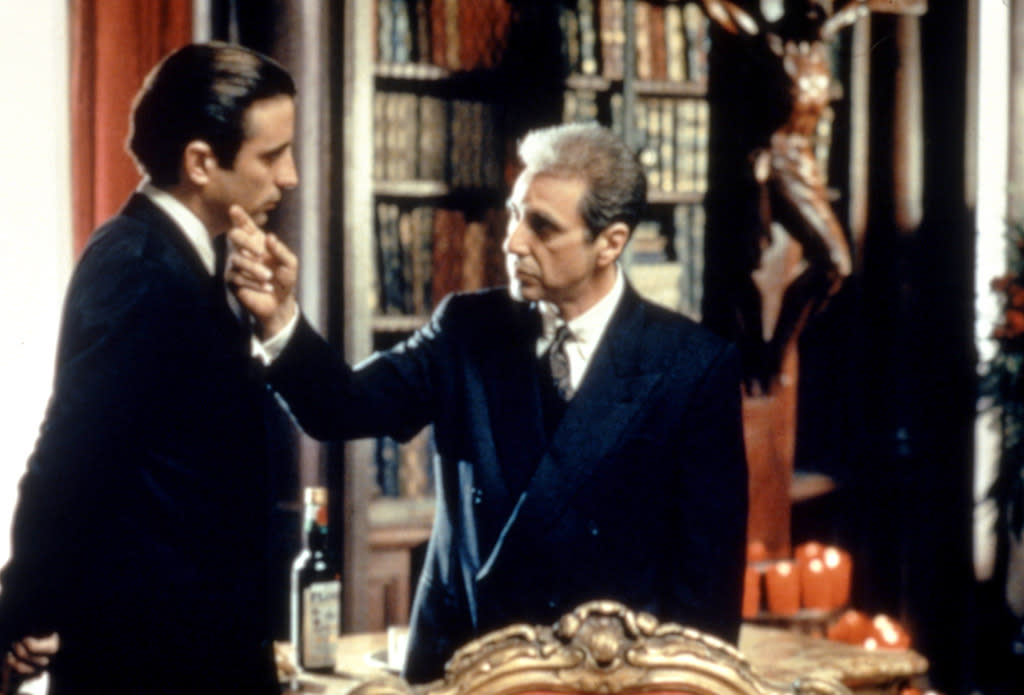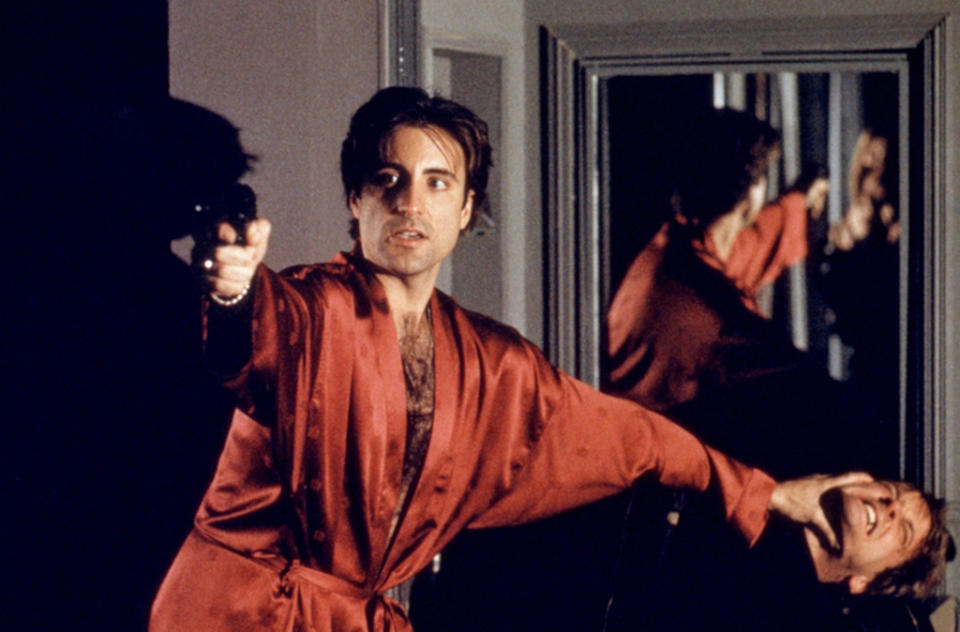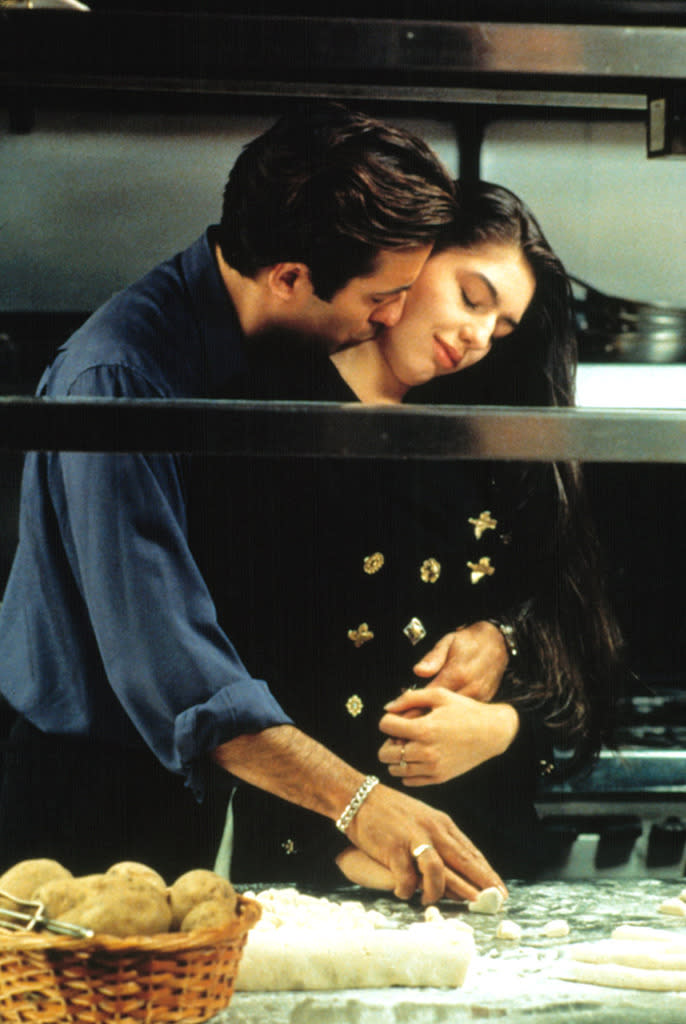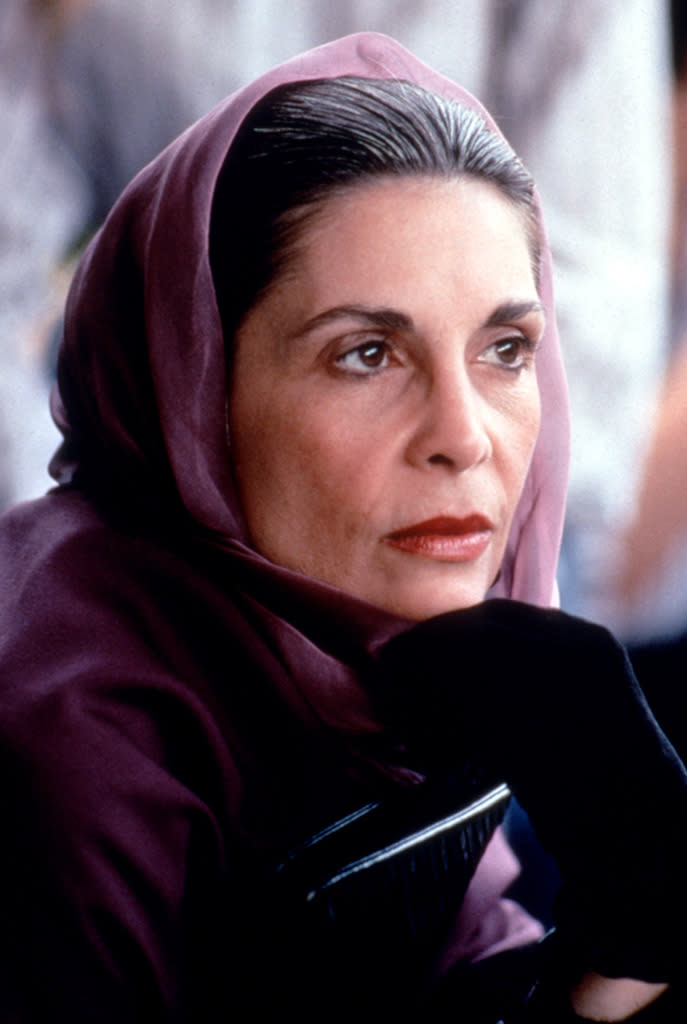'The Godfather Part III' Turns 25: 5 Reasons It Deserves a Second Look

Andy Garcia and Al Pacino (Everett)
Twenty-five years ago this month, Francis Ford Coppola gifted moviegoers with a Christmas present many had hoped to see for decades: another chapter in the filmmaker’s career-defining Godfather saga. Released by Paramount in 1972 and 1974 respectively, The Godfather and The Godfather Part II are Hall of Fame gangster movies that, to date, remain the only original-and-sequel pair to win Best Picture statues. Coppola had declared himself finished with the Corleone family in the wake of Part II, which famously ended with Mafioso Michael Corleone (Al Pacino) sitting abandoned and alone, his wife and children gone, and his brother Fredo killed on his own orders. It seemed like the logical conclusion to the tale of one man’s corruption.
To borrow an oft-quoted line from The Godfather Part III, though, just when Coppola thought he was out, they pulled him back in. In the years following The Godfather Part II, the director took spectacular gambles, some of which paid off (Apocalypse Now and The Outsiders), while others took a sizeable financial toll (One From the Heart and The Cotton Club). By 1990, the director’s mounting debts required him to finally say “Yes” to making another Godfather film. “It never would have been made except for the difficulties [I faced],” Coppola remarks ruefully on a DVD commentary track recorded for The Godfather Part III. The director also reveals that the studio Paramount gave him less than a year to make the third chapter and proposed a storyline that would be more in the spirit of the first two films, focusing on Michael’s nephew — and Sonny Corleone’s illegitimate son — Vincent (played by Andy Garcia), as he rose to power against the backdrop of the ‘70s drug trade.

Andy Garcia (Everett)
But Coppola felt strongly that Michael needed to remain the central figure. So the story he concocted along with original Godfather novelist Mario Puzo, follows an elderly Michael attempting to divest himself and the Corleone name from any illegitimate activities by donating a substantial sum to the Vatican, receiving a lucrative business opportunity in return. But redemption is difficult to achieve, let alone purchase, and Michael soon discovers that he’s not finished paying for his crimes. “This would not be the Michael Corleone that audiences had come to love,” Coppola says on the commentary track, adding that his preferred title for the third installment was always The Death of Michael Corleone. “The film was, against our wishes, called The Godfather Part III. I’d like the audience to think of the films as two sequels and an epilogue.”
Watch the trailer for ‘The Godfather Part III:’
Coppola was right to suspect that Godfather fanatics might not respond favorably to Michael’s last chapter. The movie opened to markedly mixed reviews and word-of-mouth on Christmas Day, 1990, with numerous complaints about the movie’s dour mood and slow pace. Special ire was reserved for the director’s decision to cast his then-19-year-old daughter Sofia in the pivotal role of Mary Corleone, Michael’s beloved (and doomed) daughter. The younger Coppola — now a successful writer-director in her own right — only stepped into the role after Winona Ryder dropped out right as production started. “It was really Sofia that I had in mind when I created the character of Mary, the apple of her father’s eye,” Coppola operatically explains in his director’s commentary. “Sofia was plunged into an important role and, just like in the story, it was Sofia [the media] really shot the bullet at when they were aiming at me…as if to say, ‘He’s vulnerable here, kill him here.’"
Revisiting The Godfather Part III on its 25th anniversary — well-removed from the expectations of having to follow two of the most influential films ever made — it’s possible to see the film’s many virtues amid its obvious flaws. True, it’s a substantively different creature than its predecessors, but Coppola’s valiant attempts to push Michael’s story forward, rather than simply repeat himself, are worthy of admiration. (It’s worth noting that, despite the lukewarm reaction at the time, the film still received Best Picture and Best Director nominations.) Here are five legitimately great things about the long-derided Godfather finale.

Andy Garcia and Sofia Coppola (Everett)
5. Gnocchi rolling with Mary and Vincent
You can’t start a discussion about The Godfather Part III without confronting the Sofia Coppola issue head-on. So let’s not beat around the bush: Despite having had small parts in some of her father’s previous films, the novice actress is clearly out of her depth here, unprepared for the demands of the role or the intense backlash her casting inspired. On the commentary track, Coppola alludes to poor treatment she received on set from various crew members that diminished her already shaky confidence. Still, he refers to Sofia as one of his favorite parts of the film, encouraging viewers to look past her shaky line readings and pay attention to her presence: “If you look at her eyes, she’s full, she’s there [in the scene].” That may be why Sofia’s best scene is also her simplest: Visiting her cousin, Vincent — on whom she has a serious crush — Mary helps him roll gnocchi for his crew’s dinner. Under his tender eye and steady hand, they add to the growing pile of dough dumplings (employing a method practiced by the Coppola family in their own kitchen) until Mary looks over and admits quietly, “I love you, cuz.” For all the false notes she strikes elsewhere in the film, this one moment rings sweetly true.

Talia Shire (Everett)
4. Talia Shire
Coppola had precedent for casting his daughter in The Godfather Part III. After all, his sister Talia Shire had been a vital part of the Corleone family since the very first movie. In the original Godfather, Shire’s Connie is largely a victim, abused by her husband and used as a pawn in the assassination of her beloved brother Sonny (James Caan). In Part II, she tentatively re-enters Michael’s circle, while still remaining a satellite in larger family affairs. But as Michael retreats from power during the period separating Part II and Part III, Connie’s influence grows stronger. It’s she who encourages her brother to cede more and more responsibility to Vincent, and is present in the room when Sonny’s child ultimately becomes the new Don Corleone. And as her coup de grâce, Connie kills the man who has set himself up as the architect of the Corleone’s hoped-for downfall: Eli Wallach’s quietly treacherous Don Altobello is offed by a batch of poisoned cannoli. Connie’s transformation into a black widow is subtly portrayed by Shire, who delivers understated, but memorable work throughout. Coincidentally, 1990 marked the last time that the actress reprised her two signature roles: the month before The Godfather Part III’s release, she returned as Adrian Balboa in the ill-fated Rocky V. Adrian was killed off for follow-ups Rocky Balboa and Creed, but Connie receives a much better send-off.
Watch the massacre scene:
3. The Atlantic City massacre
Left to his own devices, Coppola likely would have foregone any Mafia shenanigans entirely. But the studio demanded a few action-driven set pieces in classic Godfather tradition. “There were many obligations…to drum up interesting violent sequences, and kill a bunch of people in a way we hadn’t before,” Coppola says wearily on the commentary track. Despite his reluctance, the director did marshal his creative powers to conceive of this memorable bit of bloodletting in which would-be kingpin Joey Zasa (Joe Mantegna) brutally executes the high-ranking members of the Mafia Commission by a machine-gun mounted on a helicopter, reducing a lavish Atlantic City hotel suite to smithereens. Michael’s obliviousness to the impending danger is something that Coppola says he wanted to highlight in this sequence. “Michael doesn’t care about this stuff anymore…. The younger Michael perhaps would have outsmarted them. [Audiences] wanted to see the old Michael who was one step ahead of [his enemies], and it was hard to have him be more concerned with matters of his heart and his soul.”
Watch the confession scene:
2. Michael’s Confession
Speaking of soul, Michael nakedly bares his in what has to rank as one of the single best scenes in the entire Godfather series. Paying a visit to Cardinal Lamberto (played by Italian screen legend, Raf Vallone) who is later elected Pope — the character is loosely modeled after Albino Luciani, who became Pope John Paul I in 1978 — Michael finally confesses to the demons that have been following him around all these years, including the ever-present specter of slain brother Fredo. Rather than offer him comfort, Lamberto’s words are a stern tonic: “Your sins are terrible and it is just that you suffer. Your life could be redeemed. But I know that you don’t believe that. You will not change.” In general, the Vatican storyline is the most compelling dramatic material in The Godfather Part III, highlighting how Michael’s attempt at redemption embeds him in another nest of vipers. And this sequence encapsulates the impossibility of his quest.
Watch the assassination scene:
1. Al Pacino
Pacino actually played two gangsters in 1990: Michael Corleone in The Godfather Part III and Big Boy Caprice in Warren Beatty’s Dick Tracy. At the time, the larger-than-life Tracy performance is the one that won raves and an Oscar nomination. But Pacino’s subdued presence in Part III has aged much better. The actor successfully tamps down his showboating tendencies, making it clear that the character is already something of a walking ghost before his eventual earthly demise, sitting alone in the courtyard of his Sicilian villa at the very end. According to Coppola, the circumstances of Michael’s death were very different in the original script: He was supposed to take a bullet instead of Mary. But the director opted to bestow one last punishment on his main character. Michael’s prolonged scream over Mary’s prone body isn’t just for her — it’s a recognition that his life is over as well.


